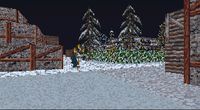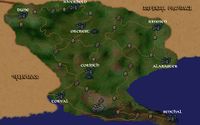Lore:Alabaster
| Alabaster | |
|---|---|
| Type | Settlement |
| Continent | Tamriel |
| Province | Elsweyr |
| Region | Pellitine |
| Appears in | Arena |
This article is about the city. For the mineral, see Alabaster (mineral).
Alabaster (alternatively known as Al'basti in Ta'agra)[1] is one of the eight major cities in the province of Elsweyr,[2] found on the southeastern coast of the province on the Topal Bay.
The town is known for the great white walls that surround the city, hence the name.[3] Alabaster was one of the original sixteen kingdoms of Elsweyr, known for their bards, playwrights, poets,[4] and spices.[5] A small unnamed town is located outside the city walls, to the west.[6]
Layout & Geography[edit]
Alabaster is a port city found on the northern edge of the Topal Bay, just west of the Elsweyr provincial border with Cyrodiil and the Lower Niben, being the closest city to Leyawiin. Alabaster is in the region of Pellitine, which is known for its jungles, rainforests, and river basins.[7] Large hills separate it from both the Quin'rawl Peninsula and Blackwood. Alabaster is neighbored by several settlements, including Darkarn Place to the west, and Valley Guard to the northwest.[2] The white Alabaster jerboa is named after the city.[8]
History[edit]
Alabaster was one of the sixteen sovereign states of modern-day Elsweyr and was known for their dramatists, and once had a Bard-Queen.[4] But like the other kingdoms, Alabaster dissolved with the arrival of the Thrassian Plague in 1E 2260 and the weakened states of the south were absorbed into the Kingdom of Pa'alatiin, modern-day Pellitine.[9][10]
In 2E 560, the Knahaten Flu reached the harbors of Alabaster, following their outbreak on the harbor-city of Senchal. After it appeared in Alabaster, it spread across the rest of the province. The Khajiit overcame the flu, and with the intervention from the First Aldmeri Dominion, the flu was nigh extinction.[11]
Sometime around 2E 582, Alabaster traded with the city of Anvil, when it was ruled by the Provisional-Governor, Fortunata ap Dugal.[12] The Canonreeve and Dominion representative of Alabaster, Lord Juz-do, traveled to the northern town of The Stitches and met with Rigurt the Brash, an ambassador of the Ebonheart Pact. He presented him with a sabre cat fur coat, one of the finest in all of Skyrim, which proved to be a blunder as the Canonreeve was horrified by the use of slaughtered cats as clothing and proceeded to storm out.[13]
During the Imperial Simulacrum in the late Third Era, the city-state of Alabaster was an active settlement. It was ruled by King Mojnir, and it had a rivalry with Rimmen and Senchal.[3] Around this time, a scribe from Alabaster learned that the legendary sword of heroes, Chrysamere, had resurfaced somewhere in Tamriel. Rumors spread across the continent about Chrysamere's certain return, and the weapon was subsequently recovered by the Eternal Champion.[14]
Gallery[edit]
Notes[edit]
- Arena was originally conceived as a fighting game featuring a tournament that took the player to each of Tamriel's cities to challenge different gladiatorial teams. According to a file from that stage of development left behind in the final game, Alabaster's gladiatorial team would have been called "the Nightrunners".[UOL 1]
- In the mid-Second Era, the youth of Alabaster purportedly found it fashionable to place their honorifics before their names, rather than after in the typical Khajiiti custom of that time—a practice which seemed to have spread to other Khajiit by the Third Era.[15]
- There is an expression that goes "You couldn't find an Alfiq in Alabaster!",[16] suggesting it may host a sizeable population of Alfiq.
References[edit]
- ^ Rajhin's Shadow's dialogue in ESO: Elsweyr
- ^ a b Map of Elsweyr – The Elder Scrolls: Arena
- ^ a b Alabaster location and rumors in Arena
- ^ a b The Sixteen Kingdoms
- ^ Tithereeve Atofir's dialogue in ESO
- ^ The Night Mother's dialogue during Whispers of Death in Oblivion
- ^ Pocket Guide to the Empire, 1st Edition: The Elsweyr Confederacy — Imperial Geographical Society, 2E 864
- ^ Alabaster Jerboa description in ESO
- ^ Pocket Guide to the Empire, 3rd Edition: Sugar and Blood: the Cats of the South — Imperial Geographical Society, 3E 432
- ^ Anequina and Pellitine: An Introduction — Sulema, Initiate Scholar of the Pa'alatiin
- ^ The Eagle and the Cat — Lord Gharesh-ri, Speaker for the Mane
- ^ Free Market of the People
- ^ Cross-cultural Confusion quest in ESO
- ^ Artifact Dialogue — The Elder Scrolls: Arena
- ^ Khajiiti Honorifics — Lady Radurra-dra of Torval
- ^ Dragonguard Orland's dialogue in ESO
Note: The following references are considered to be unofficial sources. They are included to round off this article and may not be authoritative or conclusive.



